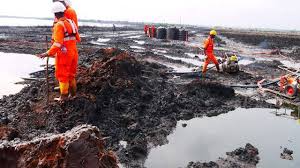$1 Billion and 30 years, that’s how much and how long it will take to cleanup Ogoni land

One of the prominent areas in the Niger Delta that has been the site of Nigeria’s oil industry operations since the late 1950s. Decades of crude oil exploitation, exploration, and production activities have led to severe environmental degradation that has created complex problems for these communities.
For over sixty years, the Ogoni people have sacrificed their habitat for the oil wealth Nigeria enjoys today; their rights have been violated in favour of multinational companies which exploit their natural resources, while those who oppose the presence of such corporations in their territories suffer harassment, death threats and targeted assassinations.
Let’s take it back….
The British government in collaboration with Shell launched oil exploration in the Niger Delta a few years before Nigeria’s independence and between 1976 to 1991, there were reportedly 2,976 oil spills (about 2.1 million barrels of oil daily) in Ogoni. This singular catastrophe alone accounts for about 40% of total oil spills of the Royal Dutch/Shell company worldwide.
Because of oil flaring, and waste discharge, the alluvial soil of the Niger Delta is no longer viable for agriculture. In many areas that seemed to be unaffected, groundwater was found to have high levels of hydrocarbons or were contaminated with carcinogen, at 900 levels above WHO guidelines.
Ogoni dwellers have suffered heightened deprivation of livelihood means due to severe oil pollution and associated consequences, leading to conflicts and disagreement between parties involved. Several advocacy groups and international bodies clamoured for the revamp of the land so its people can live normal and healthy lives again but negotiations and protests failed to bring about the desired solutions, not until the current administration came into power.
Exposed!! Popular Abuja doctor revealed how men can naturally and permanently cure poor erection, quick ejaculation, small and shameful manhood without side effects. Even if you are hypertensive or diabetic . Stop the use of hard drugs for sex!! It kills!
Where we are now…
In August 2017, Nigeria’s Vice-President Yemi Osinbajo, on behalf of President Muhammadu Buhari, launched a $1 billion clean-up and restoration programme of Ogoni, announcing that financial and legislative frameworks had been put in place to begin implementing recommendations made by the United Nations Environment Programme (UNEP) in 2012, but work didn’t begin until January 2019.
President Buhari also ordered the redeployment of the Niger Delta Development Commission from the Office of the Secretary to the Government of the Federation, to the Ministry of Niger Delta Affairs, promising increased commitment to enhancing the living standards of the Niger Delta communities through coordinated and appropriate programmes.
At a conference in New York in September 2019, Buhari announced plans and initiatives by his administration to reverse the negative effects of climate change in Nigeria, stating clearly that the government remains equally resolute in its efforts to combat militant attacks on the nation’s oil and gas facilities in the Niger Delta and accelerate the Ogoni clean-up to address long-standing environmental challenges.
After many years of ineffectiveness, the Hydrocarbon Pollution and Remediation Project (HYPREP) under the Federal Ministry of Environment is now working tirelessly to clean up the oil spills in Leme, Gokana, Khana and Tai. While the cleanup process has begun, the government says it faces some challenges in its implementation including land tussles amongst indigenes, youth restiveness and chieftaincy stool but that’s not enough reason to back down on its promises, a close source to the presidency noted, assuring hat 2020 will see an increase in activities on the sites as well as take all the UNEP recommendations as emergency cases.
At most of the sites, contractors are already excavating and treating contaminated soils, while some have even completed the process of excavation and are back filling treated soils. The government has called on stakeholders to assist on delivering its mandate and avoid any cases of re-pollution. It says efforts to clean Ogoni land could amount to nothing if after investing so much resources and time, it is again re-polluted by activities of illegal bunkers and refiners.
60% of the world’s natural resources are located in indigenous lands. The right of indigenous peoples to participate in the profits of oil recovery is very rarely emphasized. The only way to sustainable development is through participation all stakeholders in decision- making process. This is why 90 per cent of the workforce of HYPREP is made up of Ogoni people even though it’s a national project.
320 Ogoni youths actively engaged on the sites while 21 of them were sent to Geneva, Switzerland, to undergo further training on remediation. More job opportunities are being created and skill acquisition programmes keep springing up. There’s also a new agreement on rehabilitation of moribund Rivers State Water facilities in Ogoniland and use of the state’s facilities to conduct Health Impact study in the areas.
2050 may seem like a long time because it is, but the Buhari-Osinbajo administration seems committed to empowering Ogoni indigenes, providing livelihood packages, more work plans, infrastructure and projects focused on environmental restoration of the area.
Richard Ogundiya is a researcher and journalist based in Lagos, Nigeria.




